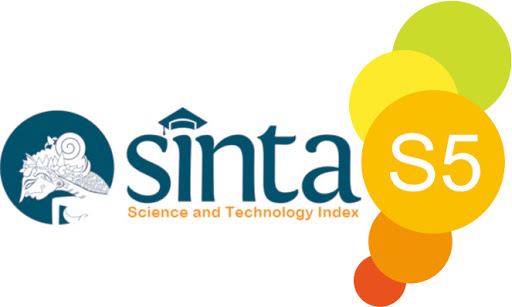Morphological Grayscale Pre-processing to SAR Images for Reducing Noise in Ship Detection Based on YOLOv8
Abstract
Keywords
Full Text:
PDFReferences
Alsalman, H. (2019). Enhancing Digital Mammogram Images using Bandpass Filters in Frequency Domain. 19(11), 107–113.
Choi, H., and Jeong, J. (2019). Speckle noise reduction technique for sar images using statistical characteristics of speckle noise and discrete wavelet transform. Remote Sensing, 11(10).
Cumming, I. G., and Wong, F. H. (2005). Digital Processing of Synthetic Aperture Radar Data : Algorithms ad Implementation. Massachusetts. Artech House.
Gonzalez, R. C., and Woods, R. E. (Richard E. (2018). Digital image processing (4th Editio).
Han, X., Zhao, L., Ning, Y., and Hu, J. (2021). ShipYOLO: An Enhanced Model for Ship Detection. Journal of Advanced Transportation, 2021.
Hidayatullah, D. P. (2021). Buku Sakti Deep Learning. Stunning Vision AI Academy.
Hidayatullah, P. (2017). Pengolahan Citra Digital Teori dan Aplikasi Nyata.
Huang, H., Sun, D., Wang, R., Zhu, C., and Liu, B. (2020). Ship Target Detection Based on Improved YOLO Network. Mathematical Problems in Engineering, 2020.
Hussain, M. (2024). YOLOv1 to v8: Unveiling Each Variant-A Comprehensive Review of YOLO. IEEE Access, 12(March), 42816–42833.
Ma, M., and Pang, H. (2023). SP-YOLOv8s: An Improved YOLOv8s Model for Remote Sensing Image Tiny Object Detection. Applied Sciences (Switzerland), 13(14).
Muhamad Itikap, S., Syahid Abdurrahman, M., Soewono, E. B., and Gelar, T. (2023). Geometry and Color Transformation Data Augmentation for YOLOV8 in Beverage Waste Detection. Journal of Software Engineering, Information and Communication Technology (SEICT), 4(2), 123–138.
Nashuha, S. H., Ali, E. Y. E., and Wijanto, H. (2016). Pemrosesan Raw Data Sar (Synthetic Aperture Radar) menjadi Sar Image Space. E-Proceeding of Engineering, 3(3), 4450–4457.
Onyedinma, E. G., and Onyenwe, I. E. (2023). Image Restoration: A Comparative Analysis of Image De noising Using Different Spatial Filtering Techniques. International Journal of Latest Technology in Engineering, Management,& Applied Science (IJLTEMAS), 12(9), 55–63.
Shabbir, Z., Sarosh, A., and Nayyer, M. (2019). Space technology applications for maritime intelligence, surveillance, and reconnaissance. Astropolitics, 17(2), 104–126.
Syam’ani, S.Hut., M. S. (2019). Dasar-dasar Teknologi SAR. PPIIG ULM.
Wei, S., Zeng, X., Qu, Q., Wang, M., Su, H., and Shi, J. (2020). HRSID: A High-Resolution SAR Images Dataset for Ship Detection and Instance Segmentation. IEEE Access, 8, 120234–120254.
Yaseen, M. (2024). What is YOLOv8: An In-Depth Exploration of the Internal Features of the Next-Generation Object Detector. 8, 1–10.
Zhao, C., Fu, X., Dong, J., Qin, R., Chang, J., and Lang, P. (2022). SAR Ship Detection Based on End-to-End Morphological Feature Pyramid Network. IEEE Journal of Selected Topics in Applied Earth Observations and Remote Sensing, 15, 4599–4611.
DOI: https://doi.org/10.17509/seict.v5i2.75970
Refbacks
- There are currently no refbacks.
Copyright (c) 2024 Journal of Software Engineering, Information and Communication Technology (SEICT)

This work is licensed under a Creative Commons Attribution-ShareAlike 4.0 International License.
Journal of Software Engineering, Information and Communicaton Technology (SEICT),
(e-ISSN:2774-1699 | p-ISSN:2744-1656) published by Program Studi Rekayasa Perangkat Lunak, Kampus UPI di Cibiru.
Indexed by.





